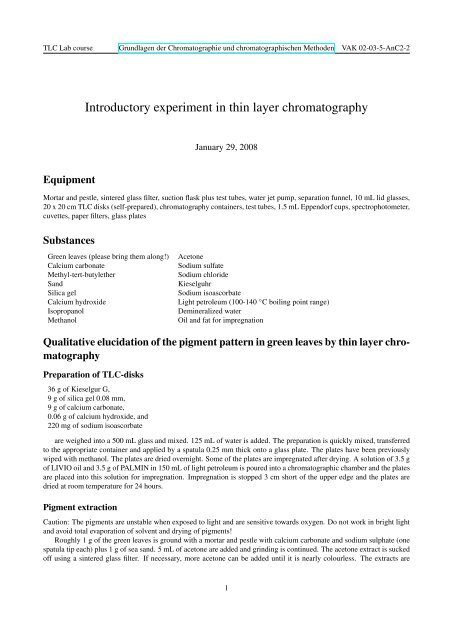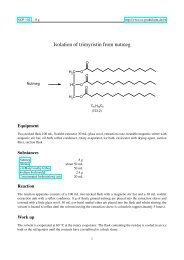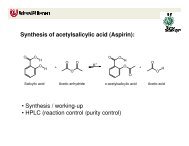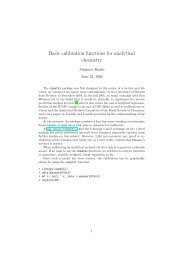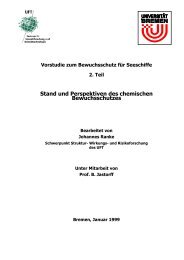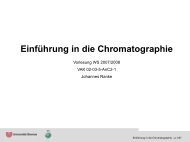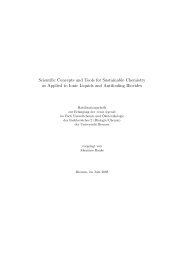Thin layer chromatography experiments
Thin layer chromatography experiments
Thin layer chromatography experiments
You also want an ePaper? Increase the reach of your titles
YUMPU automatically turns print PDFs into web optimized ePapers that Google loves.
TLC Lab course Grundlagen der Chromatographie und chromatographischen Methoden VAK 02-03-5-AnC2-2<br />
Introductory experiment in thin <strong>layer</strong> <strong>chromatography</strong><br />
January 29, 2008<br />
Equipment<br />
Mortar and pestle, sintered glass filter, suction flask plus test tubes, water jet pump, separation funnel, 10 mL lid glasses,<br />
20 x 20 cm TLC disks (self-prepared), <strong>chromatography</strong> containers, test tubes, 1.5 mL Eppendorf cups, spectrophotometer,<br />
cuvettes, paper filters, glass plates<br />
Substances<br />
Green leaves (please bring them along!)<br />
Calcium carbonate<br />
Methyl-tert-butylether<br />
Sand<br />
Silica gel<br />
Calcium hydroxide<br />
Isopropanol<br />
Methanol<br />
Acetone<br />
Sodium sulfate<br />
Sodium chloride<br />
Kieselguhr<br />
Sodium isoascorbate<br />
Light petroleum (100-140 ◦ C boiling point range)<br />
Demineralized water<br />
Oil and fat for impregnation<br />
Qualitative elucidation of the pigment pattern in green leaves by thin <strong>layer</strong> <strong>chromatography</strong><br />
Preparation of TLC-disks<br />
36 g of Kieselgur G,<br />
9 g of silica gel 0.08 mm,<br />
9 g of calcium carbonate,<br />
0.06 g of calcium hydroxide, and<br />
220 mg of sodium isoascorbate<br />
are weighed into a 500 mL glass and mixed. 125 mL of water is added. The preparation is quickly mixed, transferred<br />
to the appropriate container and applied by a spatula 0.25 mm thick onto a glass plate. The plates have been previously<br />
wiped with methanol. The plates are dried overnight. Some of the plates are impregnated after drying. A solution of 3.5 g<br />
of LIVIO oil and 3.5 g of PALMIN in 150 mL of light petroleum is poured into a chromatographic chamber and the plates<br />
are placed into this solution for impregnation. Impregnation is stopped 3 cm short of the upper edge and the plates are<br />
dried at room temperature for 24 hours.<br />
Pigment extraction<br />
Caution: The pigments are unstable when exposed to light and are sensitive towards oxygen. Do not work in bright light<br />
and avoid total evaporation of solvent and drying of pigments!<br />
Roughly 1 g of the green leaves is ground with a mortar and pestle with calcium carbonate and sodium sulphate (one<br />
spatula tip each) plus 1 g of sea sand. 5 mL of acetone are added and grinding is continued. The acetone extract is sucked<br />
off using a sintered glass filter. If necessary, more acetone can be added until it is nearly colourless. The extracts are<br />
1
TLC Lab course Grundlagen der Chromatographie und chromatographischen Methoden VAK 02-03-5-AnC2-2<br />
combined in a small separation funnel and 2 mL of methyl-tert-butylether, 5 mL of a 10% (w/w) sodium chloride solution<br />
are added. After careful shaking and slight opening of the separation funnel the water-like, clear lower phase containing<br />
acetone is separated off. During shaking, be sure to vent the funnel regularly. The dark green ether phase is washed twice,<br />
each with 3 mL of water. A spatula tip of dry sodium sulphate is added to the extract.<br />
<strong>Thin</strong> <strong>layer</strong> <strong>chromatography</strong><br />
The experiment requires impregnated and non-impregnated plates. The chromatographic chambers have to be saturated<br />
prior to the experiment.<br />
The eluent system for the non-impregnated plates consists of<br />
• 100 mL of petrol ether (boiling point range of 100-140 ◦ C),<br />
• 12 mL of 2-propanol and<br />
• 0.25 mL of water.<br />
The solvent system for impregnated plates contains<br />
• 120 mL of methanol,<br />
• 24 mL of acetone and<br />
• 18 mL of water.<br />
The mixture must be saturated with lipoids. Hence 3 g of LIVIO oil plus 3 g of PALMIN are molten in a water bath<br />
and added to the solvent mixture. After thorough mixing (shaking), settling and decanting, the upper phase is transferred<br />
into the chromatographic chamber.<br />
The non-impregnated plates are activated at 80 ◦ for 30 minutes prior to applying the extracts. Impregnated and nonimpregnated<br />
plates are positioned horizontally and the concentrated extract is carefully applied as a 2-4 mm band in a<br />
2.5 cm distance from the lower edge of the plate by means of a pipette. Keep off the edges by about 2 cm. Optionally<br />
you may apply again after the solvent has evaporated. In the case of the unimpregnated plates apply on the upper, nonimpregnated<br />
edge, which is now to become the lower edge. Be careful not to damage the coating of the plates which is<br />
not as hard as the commercially available material.<br />
After application, the solvent system in the chambers is thoroughly mixed once again and the plates are put into the<br />
chambers. Make sure the lid fits tight and keep the chambers in the dark.<br />
Development time is between 30 and 90 min.<br />
Isolation and identification of individual components in the pigment extracts:<br />
With a spatula the carotene, chlorophyll and xanthophyll bands are carefully removed from the moist plate and are transferred<br />
to the test tubes. 3 to 5 mL solvent (see below) is added and the mixture is suspended. After settling of the silica gel,<br />
about 1 mL of the supernatant is carefully transferred to a 1.5 mL Eppendorf cup and put into the centrifuge. Absorption<br />
spectra are to be taken from all extracts.<br />
Solvents for extraction from the silica gel:<br />
plate type band solvent<br />
non-impregnated all bands acetone<br />
impregnated chlorophyll acetone<br />
impregnated carotene petrol ether<br />
impregnated xanthophyll ethanol<br />
2
TLC Lab course Grundlagen der Chromatographie und chromatographischen Methoden VAK 02-03-5-AnC2-2<br />
Reporting the results<br />
1. Chromatograms are documented on transparent paper, technical data is noted (<strong>layer</strong>, <strong>layer</strong> thickness, solvent system,<br />
start, solvent front, duration, colour of the bands).<br />
2. The results of both chromatographic techniques (with and without lipid impregnation) are discussed. Rp-values are<br />
correlated with the chemical structure of the pigment.<br />
3. The characteristics of absorption curves are discussed.<br />
3


